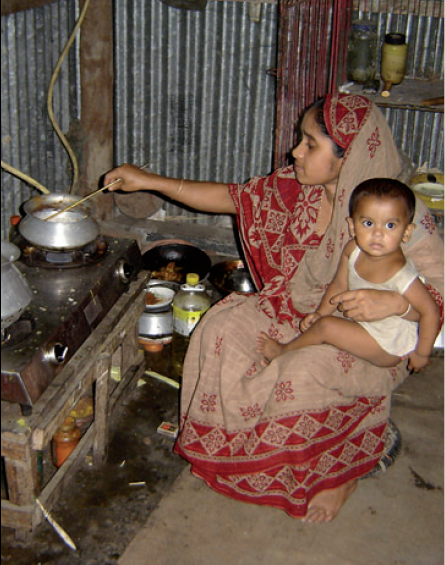Biogas Combustion
|
In principal, biogas can be used like other fuel gas. When produced in household-level biogas reactors, it is most suitable for cooking. Additionally, electricity generation is a valuable option when the biogas is produced in large anaerobic digesters. Household energy demand varies greatly and is influenced by cooking and eating habits (i.e., hard grains and maize may require substantial cooking times, and, therefore, more energy compared to cooking fresh vegetables and meat). Biogas has an average methane content of 55-75% and carbon dioxide of 40%, produced by anaerobic digestion of organic material, usually animal dung, human excreta and crop residue. This implies an energy content of 6-6.5 kWh/m3. Small-scale biogas digesters provide fuel for domestic lighting, cooling and cooking (see Anaerobic Biogas Reactor). Large-scale biogas plants are able to produce sufficient gas to fuel engines to generate electricity. The (thermal) energy available from biogas is about 6 kWh/m³. This corresponds to half a litre of diesel oil and 5.5 kg of firewood. 1 kg of human faeces generates about 50 litres of biogas: 1 kg of cattle dung delivers 40 litres of biogas, and 1 kg of chicken droppings generates about 70 litres of biogas. ContentsDesign ConsiderationsGas demand can be defined on the basis of energy previously consumed. For example, 1 kg firewood roughly corresponds to 200 L biogas, 1 kg dried cow dung corresponds to 100 L biogas and 1 kg charcoal corresponds to 500 L biogas. Gas consumption for cooking per person and per meal is between 150 and 300 L biogas. Approximately 30-40 L biogas is required to cook one litre of water, 120-140 L for 0.5 kg rice and 160-190 L for 0.5 kg vegetables. Tests in Nepal and Tanzania have shown that the consumption rate of a household biogas stove is about 300-400 L/h. However, this depends on the stove design and the methane content of the biogas. The following consumption rates in litres per hour (L/h) can be assumed for the use of biogas:
Compared to other gases, biogas needs less air for combustion. Therefore, conventional gas appliances need to be modified when they are used for biogas combustion (e.g., larger gas jets and burner holes). The distance through which the gas must travel should be minimized since losses and leakages may occur. Drip valves should be installed for the drainage of condensed water, which accumulates at the lowest points of the gas pipe.  Biogas as source of energy, in Bangladesh (for credits, click the picture)
Applying conditionsThe main prerequisite of biogas use is the availability of specially designed biogas burners or modified consumer appliances. In some cases, especially at larger scale, further treatment or conditioning of biogas is necessary before it is ready to use. Treatment aims to remove water, hydrogen sulphide or carbon dioxide from the raw gas. Safety measures are needed, especially to reduce the risk of explosion in case of leakages. AppropriatenessThe calorific efficiency of using biogas is 55% in stoves, 24% in engines, but only 3% in lamps. A biogas lamp is only half as efficient as a kerosene lamp. The most efficient way of using biogas is in a heat-power combination where 88% efficiency can be reached. But this is only valid for larger installations and under the condition that the exhaust heat is profitably used. For household application, the best way to use biogas is cooking. Health Aspects/AcceptanceIn general, users enjoy cooking with biogas as it can immediately be switched on and off (as compared to wood and coal). Also, it burns without smoke, and, thus, does not lead to indoor air pollution. Biogas generated from faeces may not be appropriate in all cultural contexts. Assuming that the biogas plant is well-constructed, operated and maintained (e.g., water is drained), the risk of leaks, explosions or any other threats to human health is negligible. Operation & MaintenanceBiogas is usually fully saturated with water vapour, which leads to condensation. To prevent blocking and corrosion, the accumulated water has to be periodically emptied from the installed water traps. The gas pipelines, fittings and appliances must be regularly monitored by trained personnel. When using biogas for an engine, it is necessary to first reduce the hydrogen sulphide because it forms corrosive acids when combined with condensing water. The reduction of the carbon-dioxide content requires additional operational and financial efforts. As CO2 “scrubbing” is not necessary when biogas is used for cooking, it is rarely advisable in developing countries. Field experiences
Manuals, videos, and links
References
AcknowledgementsThe material on this page was adapted from: Elizabeth Tilley, Lukas Ulrich, Christoph Lüthi, Philippe Reymond and Christian Zurbrügg (2014). Compendium of Sanitation Systems and Technologies, published by Sandec, the Department of Water and Sanitation in Developing Countries of Eawag, the Swiss Federal Institute of Aquatic Science and Technology, Dübendorf, Switzerland. The 2nd edition publication is available in English. French and Spanish are yet to come. |
|||||||||||||||||



